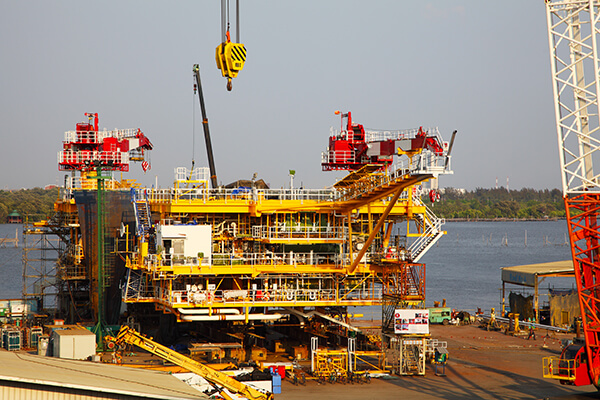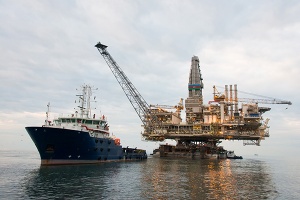Asian energy stocks fell with oil after the world’s biggest crude producers failed to agree on supply cuts, while rising metals prices in China spurred gains in mining shares. Gold was buoyed by haven demand following the reopening of an FBI probe into Hillary Clinton.
The MSCI Asia Pacific Energy Index and crude both slipped to one-month lows after the Organization of Petroleum Exporting Countries ended two days of talks on Saturday without agreeing any individual quotas. A gauge of raw-materials producers climbed toward its highest level in almost four months as aluminum and zinc rallied to multi-year highs in Shanghai. Gold rose for a third day after a survey pointed to cooling support for Clinton before next week’s U.S. presidential election, while the rand gained versus major peers.
Global equities have lost ground in October as mixed corporate earnings meld with investor anxiety ahead of the Nov. 8 vote in the U.S. and expectations the Federal Reserve will hike interest rates before the year is out. The S&P 500 Index slid 20 points in about 40 minutes on Friday amid news the Federal Bureau of Investigation was again looking into Clinton’s use of private e-mail while secretary of state, an issue that has dogged her campaign. OPEC talks over two days in Vienna yielded little more than a promise that the world’s top oil producers would keep discussing ways to stabilize the market.
“Until the election, the general theme will be uncertainty, which will have implications not just on the stock market, but on the dollar and Treasuries,” said Chad Morganlander, a money manager in Florham Park, New Jersey at Stifel, Nicolaus & Co., which oversees about $180 billion. “The probability that was factored into the market and the global financial system was a Hillary Clinton victory – investors now need to square their books going into the election based on whatever new odds come out.”
Stocks
A gauge of energy shares on the MSCI Asia Pacific Index was down 0.2 percent as of 3:06 p.m Tokyo time, while a measure of raw-materials producers added 0.8 percent. About the same number of stocks rose as fell on the dollar-denominated benchmark, which has barely moved in October following a third-quarter gain of 8.4 percent that marked its best performance in more than four years.
Japan’s Topix index held near its highest level since April and the Shanghai Composite Index declined for a fourth day. Hong Kong’s Hang Seng Index advanced for the first time in a week, while markets in India and the Philippines were shut for holidays.
AIA Group Ltd. shares slumped as much as 7.2 percent after China UnionPay Co. halted credit and debt card payments for most insurance policies in Hong Kong, making it harder to conduct transactions with Chinese visitors that accounted for about half of the company’s sales in the city. Nippon Yusen KK and Mitsui O.S.K. Lines Ltd. — Japan’s two largest shipping companies — surged more than 5 percent in Tokyo after they agreed to merge their container operations with those of third-ranked Kawasaki Kisen Kaisha Ltd., which added less than 1 percent.
Futures on the S&P 500 Index rose 0.3 percent, after earlier retreating as much as 0.4 percent. An ABC/Washington Post tracking survey released Sunday gave Clinton 46 percent support from likely voters, to Trump’s 45 percent. Clinton was ahead by 12 points a week earlier.
“The race remains very tight and markets are far too complacent about the end result,” said Matthew Sherwood, head of investment strategy in Sydney at Perpetual Ltd., which manages about $21 billion. “If the polls tighten more, or the FBI investigation dominates the headlines, there could be a recalibration in market prices this week.”
Commodities
Crude oil fell 0.4 percent to $48.50 a barrel in New York. OPEC ended a meeting on Friday without reaching a deal on country quotas, according to delegates who took part in the discussions. Major producers from outside OPEC finished talks with the group on Saturday without any supply commitments, Brazil’s Oil and Gas Secretary Marcio Felix said. Oil has fluctuated near $50 amid uncertainty about whether OPEC can implement the first supply cuts in eight years at its official November meeting.
“Talks over the weekend make it seem less likely there will be an agreement on production cuts,” said Ric Spooner, a chief market analyst at CMC Markets in Sydney. “The market has probably made a fair bit of the adjustment, but I wouldn’t be surprised to see oil fall further into the $47 range.”
Gold added 0.2 percent, after rallying 0.6 percent on Friday. The metal’s gains reflect “safe-haven buying after the FBI reopened its inquiry into Hillary Clinton’s use of a private e-mail server,” Australia & New Zealand Banking Group Ltd. analysts wrote in a note on Monday.
Aluminum and zinc extended gains in Shanghai as investors bet that strong domestic demand, surging coal prices and logistical issues will underpin prices. Aluminum rose as much as 3.1 percent to its highest level since September 2014, having jumped by about 10 percent last week. Zinc climbed to the highest since March 2011.
Currencies
The Bloomberg Dollar Spot Index, a gauge of the greenback against 10 major peers, rose less than 0.1 percent after retreating 0.3 percent from a seven-month high in the last session. It’s climbed 2.2 percent this month, the biggest gain since May.
While the Fed is seen leaving policy unchanged at a review this week, futures prices indicate a 69 percent chance of an interest-rate hike at its December meeting, up from 59 percent at the end of September. American data on Monday are forecast to show personal spending and income both increased in September, based on Bloomberg surveys of economists.
The rand strengthened 0.6 percent after City Press newspaper reported that South African prosecutors may drop fraud charges against Finance Minister Pravin Gordhan, who has been a key driver of a campaign to maintain the nation’s investment-grade credit rating. The National Prosecuting Authority said Sunday there were no such plans.
The Mexican peso fluctuated near a two-week low versus the dollar, after three days of losses. Mexico’s currency tends to fall when U.S. presidential candidate Donald Trump gains ground in polls, reflecting concern about his pledges to renegotiate a free-trade agreement and deport millions of undocumented immigrants.
South Korea’s won rose 0.3 percent, having earlier sank to a three-month low as President Park Geun-hye deals with an influence-peddling scandal that’s sparked calls by the ruling party for her to remove the prime minister. Prosecutors raided Park’s office over the weekend to investigate allegations her close friend Choi Soon-sil — a private citizen whom opposition lawmakers have linked to a religious cult — wielded influence on state affairs over an extended period.
China’s yuan strengthened 0.2 percent, paring its biggest monthly loss since May. The currency advanced from near a six-year low following Friday’s retreat in the dollar and as China’s clampdown on UnionPay payments for insurance products in Hong Kong provided support. The transactions have been used as a means of skirting capital controls to take funds out of the mainland.
Bonds
The yield on U.S. Treasuries due in a decade declined one basis point to 1.84 percent, after touching a five-month high of 1.88 percent on Friday. Sovereign debt in the world’s biggest economy has lost 1.2 percent on average this month, the worst performance since February 2015, a Bloomberg index shows.
The selloff in Treasuries may pause because the FBI’s investigation of Clinton could spur demand for the safest assets, said Hiroki Shimazu, an economist and strategist at the Japanese unit of MCP Asset Management in Tokyo.
China’s one-year interest-rate swaps rose four basis points to an 18-month high of 2.75 percent in Shanghai. The increase reflects speculation policy makers will seek to keep money rates high as they tackle asset bubbles and try to stem declines in the yuan.

Oil declined for a second day as OPEC’s internal disagreements undermined efforts among major suppliers to reach an agreement in Vienna on trimming output to support prices.
Futures fell as much as 1.1 percent in New York after sliding 2.1 percent at the end of last week. The Organization of Petroleum Exporting Countries ended a meeting on Friday without reaching a deal on country quotas, according to delegates who took part in the discussions. Non-OPEC nations finished talks with the group on Saturday without any supply commitments, Brazil’s Oil and Gas Secretary Marcio Felix said. Brazil attended as an observer.
Oil has fluctuated near $50 a barrel amid uncertainty over whether OPEC can implement the first supply cuts in eight years at its official November meeting. As the gathering opened in Vienna last week, OPEC Secretary-General Mohammed Barkindo warned of the consequences if producers don’t follow through on an agreement to reduce output. The price recovery has already taken far too long and suppliers can’t risk delaying it further, he said.
“Talks over the weekend make it seem less likely there will be an agreement on production cuts,” said Ric Spooner, a chief market analyst at CMC Markets in Sydney. “The market has probably made a fair bit of the adjustment, but I wouldn’t be surprised to see oil fall further into the $47 range.”
West Texas Intermediate for December delivery dropped as much as 53 cents to $48.17 a barrel on the New York Mercantile Exchange, and was at $48.44 at 2:48 p.m. in Singapore. The contract fell $1.02 to $48.70 on Friday. Total volume traded was about 4 percent above the 100-day average. Prices are set for a third monthly gain, up 0.4 percent in October.
OPEC Meeting
Brent for December settlement, which expires Monday, lost as much as 42 cents, or 0.8 percent, to $49.29 a barrel on the London-based ICE Futures Europe exchange after falling 1.5 percent Friday. Front-month prices are up 0.7 percent this month. The global benchmark traded at a premium of $1 to WTI. The more-active January contract slid 27 cents to $50.41 a barrel.
OPEC agreed in Algiers last month to trim output to a range of 32.5 million to 33 million barrels a day and is due to finalize the deal at its Nov. 30 summit in Vienna. The accord helped push prices to a 15-month high above $50 a barrel earlier this month, although they have subsequently fallen amid doubts the group will follow through on the pledge. More than 18 hours of talks over two days in the Austrian capital this weekend yielded little more than a promise that the world’s largest producers would keep on talking.
Some progress was made at the Friday meeting on the methodology to be used for allocating output quotas to OPEC members, said one delegate, who asked not to be identified because the talks were private. Russia reiterated that it’s willing to freeze production, rather than cut, but only if there is an OPEC agreement first, according to participants in Saturday’s meeting.
Oil-market news:
-
Iraq published data showing a rare level of detail for its oil production and exports as it seeks to be excluded from OPEC’s planned output cuts because of its war with Islamic militants.
-
Libyan crude production increased to 640,000 barrels a day, according to a National Oil Corp. official.
-
China’s oil output slump shows no signs of abating as the country’s state-run energy giants hold back spending amid the crash in prices.
-
Rigs targeting crude in the U.S. fell by 2 to 441 last week, according to data from Baker Hughes Inc. Friday.

Definition of a risk: “Uncertainty concerning a loss arising due to a given set of circumstances.”
Basic principles of risk:
-
Do not hold more than you can handle in loss
-
.B. Do not risk much for little.
-
Consider probability of events and their potential impact.
-
There is no “uninsured loss”. “An uninsured loss” is equal to retention rate.
The risks that companies face around the world have drastically changed over the years. Today, in addition to the concerns of traditional risks, such as natural disasters, the risk scenario has expanded to include the risks of damage to reputation, new regulations, compliance, property damage, increased competition as in the case of Mexico, energy reform that opens up the market to private sector. Therefore it is essential to have a program that has a unique profile of risks and exposures. Which it is known as a Risk Management Program.
It is important to establish risk management: “The process of protecting the assets of an organization through an identification and analysis of exposures, controlling exposures, funding losses with internal and external funds, and implementation and monitoring of the process risk management.”
The objectives of risk management in a business include the before, during and after a loss.
Before:
-
The efficiency (competitiveness) and growth
-
Regulatory / Compliance
-
Focus on manageable risk
-
Low deviation of objectives
-
To promote stability and profit maximization
-
Cash Flow
During:
-
Protecting people
-
Protect assets3. To collect data, information and resources to recover loss / claim (internal and external)
-
Loss duration estimate / claim and lay out an adequate funding
After:
-
Survival
-
Stability (return to efficiency, competitiveness, profit maximization as soon as possible)
-
Maintain profitability or return to profitability
-
Maintain growth or return to growth
-
Good Citizenship / Social Responsibility: we must not pass as “bad,” this may represent expenses (public relations) that were not considered necessary before it occurred further loss (eg environmental disasters)
A risk management program consists of 5 stages
-
Risk Identification: The process of identifying and examining exposures of an organization a.Property (Real) b. Human Resources c. Liability d. Net Income / Net Income
-
Risk Analysis: Evaluation of the potential that the various exposures can have impact on the company; there are two types of analysis a.Qualitative analysis b. quantitative
-
Risk Control: Any action or inaction that minimizes consents, at optimal cost, probability, frequency, severity, or the uncertainty of loss a.Avoid, b. Prevent, c. Reduce, d. Segregating / separating / double, e. Transfer (whether contractual, physical, or both)
-
Risk financing obtaining internal and external funds to the best possible cost to pay for losses through two modalities
4.1 Retention: internal funds to finance losses
4.2 Transfer of responsibility: Insurance
-
Risk Monitoring: implementation and monitoring of the risk management process
In the phase of risk financing should be noted that retention generates a financial burden on companies, which are convinced that the best way of financing risks is the transfer through insurance, there is no “loss uninsured.” “An uninsured loss” is equal to a traffic jam.
In NRGI Broker, we have an expert team in comprehensive risk management and insurance programs that will provide comprehensive solutions, with proven products, which are tailored to suit your needs

Contact us, we are here to help:
Oil investors are playing it safe as OPEC hammers out the details of a deal to trim output.
Money managers reduced bets on falling prices to the lowest since May as oil held above $50 a barrel, prolonging a rally that began when the Organization for Petroleum Exporting Countries announced a deal to cut production to between 32.5 million and 33 million barrels a day. The group plans to finalize the agreement at a meeting in Vienna on Nov. 30.
“The shorts are not laughing off this OPEC deal anymore,” Phil Flynn, a market analyst at Price Futures Group in Chicago, said in a phone interview. “There’s a growing realization that there’s going to be a deal to lock in production. Things will be relatively calm until we get the agreements.”
Saudi Arabia’s Energy Minister Khalid Al-Falih said Oct. 19 that many nations are willing to join OPEC in cutting production. So far, Russia has said it’s considering taking steps to stabilize the market. Alexander Novak, the country’s energy minister, said Sunday that “many scenarios” are being discussed. Venezuelan President Nicolas Maduro, on a tour of oil-producing countries to boost support for the deal, said Oct. 21 he’s in favor of inviting the U.S. to the next OPEC meeting and creating an “alliance” of OPEC and non-OPEC nations.
“This week the market is in a pause after the run-up to $50,” said Michael Lynch, president of Strategic Energy & Economic Research in Winchester, Massachusetts. “There’s still a lot of question about what OPEC is actually going to do next month. Absent that, people are waiting for some more direction than we have now.”
In addition to slashing short bets in West Texas Intermediate crude by 21 percent during the week ended Oct. 18, hedge funds also reduced their long positions by 3.2 percent from a two-year high, according to the Commodity Futures Trading Commission. Net longs increased to the highest in two years.
Oil Inventories
WTI slipped 1 percent during the report week to $50.29 a barrel. The U.S. benchmark rose 0.1 percent on Monday to $50.91 as of 9:41 a.m. London time. Prices reached a 15-month high on Oct. 19 after government data showed U.S. crude stockpiles fell to the lowest level since January.
U.S. stockpiles dropped 5.25 million barrels to 468.7 million in the week ended Oct. 14, according to the Energy Information Administration, after reaching 512.1 million in late April.
“$50 will be the floor through the OPEC meeting, barring some spike in the dollar,” Price Futures Group’s Flynn said. “With U.S. inventories falling at a rapid pace, the prospect of a cut or freeze has real consequences.”
In other markets, net-bullish bets on gasoline rose 9.4 percent to 40,085 contracts, the highest since March 2015, as futures climbed 1.5 percent in the report week. Ultra low sulfur diesel net-longs fell 7 percent to 8,439. Futures slipped 1.2 percent.
WTI held above $50 a barrel even as Russia’s energy minister said the country may produce a new oil-output record next year. As OPEC members head into technical meetings Oct. 28-29, investors will be watching for details on country allocations. Iraq should be exempted from cutting production, Oil Minister Jabbar Al-Luaibi said Sunday.
“The market just wants to see the proof in the pudding,” said Carl Larry, director of oil and gas at consultant Frost & Sullivan in Houston. “We got to $50. That’s as good as it’s getting, going into the November election and the actual OPEC meeting.”

Russia’s energy minister met with counterparts from Saudi Arabia and other Arab Gulf oil-producers to discuss steps to stabilize crude markets amid OPEC’s drive to win cooperation from the biggest supplier outside the group in limiting output to prop up prices.
Ministers from Saudi Arabia, Kuwait, Bahrain, Qatar and the United Arab Emirates gathered in Riyadh for oil talks at the offices of the Gulf Cooperation Council secretariat. Russian Energy Minister Alexander Novak met with them later on Sunday for a separate round of talks and was expected to speak afterward at a news conference. Oman was the only one of the GCC’s six members not attending.
“Oil markets are on the way to being re-balanced,” Saudi Arabia’s Energy and Industry Minister Khalid Al-Falih said at the start of the GCC meeting. “Low oil prices are putting pressure on GCC countries’ development plans.” Russia was invited to attend the Gulf ministers’ talks, he said. “We are working with Russia and other oil producers to stabilize the market.”
Novak is set to meet representatives of the Organization of Petroleum Exporting Countries on Monday in Vienna for talks that could include production cuts, and officials from Russia and Saudi Arabia will hold bilateral discussions later this month. While Russian President Vladimir Putin has pledged to cooperate with OPEC, he’s been vague about whether the country will trim output or just freeze production at September’s post-Soviet record.
OPEC is seeking to attract other producers to join the plan it agreed to last month at a meeting in Algeria to put into effect the group’s first output cuts in eight years. Crude plunged to a 12-year low in January, squeezing the budgets of producers from Venezuela to Saudi Arabia. The price slide led OPEC to abandon its two-year-old Saudi-led policy of allowing members to pump as much as they could in an effort to protect market share.
“We hope that they can reach an overall agreement on which Russia and other non-OPEC producers will join and cooperate with OPEC members,” Iranian Oil Minister Bijan Namdar Zanganeh told reporters on Sunday in Tehran.
Iraq asked OPEC for an exemption from participation in any cuts, Oil Minister Jabber Al-Luaibi said Sunday at a news conference in Baghdad. He cited Iraq’s war against Islamic militants as the reason the country should be grouped with Iran and Nigeria as members not required to contribute to the collective cuts OPEC agreed on last month in Algeria.
Record Output
Russia is producing about 10.9 million barrels a day on average this year, according to Energy Ministry data. Officials have emphasized the nation’s ability to keep pumping; the latest draft of Russia’s energy strategy sees a potential increase in annual production from 534.1 million metric tons last year to 555 million tons, or 11.1 million barrels a day, by 2020.
OPEC’s 14 members pumped a record 33.75 million barrels a day in September, with the Saudis accounting for 10.58 million barrels, according to data compiled by Bloomberg. Output in Saudi Arabia, the group’s biggest producer, fell short of the 10.66 million-barrel-a-day record in July, the data compiled by Bloomberg show.
Brent crude, the global benchmark, has gained almost 40 percent this year, trading at about $52 a barrel last week. OPEC is trying to determine which members will reduce their output and by how much, with details to be made final at the group’s Nov. 30 meeting.

Oil investors must be getting dizzy.
In the two months since OPEC began talking about capping production, speculators’ sentiment has swung wildly, with government and exchange data showing the four biggest weekly position changes ever for the two global benchmark crudes. The latest shift is to optimism, with money managers the most bullish on West Texas Intermediate oil in two years.
“Since the summer we’ve had big moves in net length,” said Mike Wittner, head of oil-market research at Societe Generale SA in New York. “It usually has trended up or down over a couple of months. Now this is happening in a matter of weeks. We’re seeing huge shifts.”
Money managers reduced bets on lower WTI prices by more than half in the past three weeks as OPEC agreed to its first deal to cut output in eight years. That drove net length to the highest since July 2014 in the week ended Oct. 11, Commodity Futures Trading Commission data show. Brent longs also rose, leaving the combined length of the two benchmark contracts at the highest in at least five years.
The Organization of Petroleum Exporting Countries agreed on Sept. 28 in Algiers to trim output to a range of 32.5 million to 33 million barrels a day, which is due to be finalized at the Vienna summit next month. OPEC took a step toward coordinated supply curbs with Russia last week and will meet for a “technical exchange” to set a road map for output levels later this month.
The swings in sentiment have tracked the rocky road to $50 a barrel oil. Speculators’ combined WTI and Brent crude net position rose or fell more than 100,000 contracts four times in the past two months, the only moves of that size in CFTC and ICE Futures Europe data going back to 2011.
Prices began to rise after OPEC’s president said Aug. 8 that the group would hold informal talks in Algiers and Saudi Arabia signaled Aug. 11 it was prepared to discuss taking action to stabilize markets. Futures gave up most of those gains amid doubts that Saudi Arabia and Iran to reach an deal, before the agreement in Algiers sparked the latest rally.
“The change in tone from the Saudis is important,” said Kurt Billick, the founder and chief investment officer of Bocage Capital LLC in San Francisco, which manages about $432 million in commodities equities and futures. “Getting to a yes in Vienna is challenging. That they are willing to talk about a deal is a big change.”
Money managers’ short position in West Texas Intermediate crude, or bets on falling prices, shrank by 28 percent to 71,407 futures and options. Longs rose 1.8 percent to the highest since June 2014. The resulting net-long position increased 13 percent.
WTI increased 4.3 percent to $50.79 a barrel in the report week. Prices on Monday were down 0.6 percent at $50.04 a barrel as of 9:13 a.m.
Other Markets
In the Brent market, money managers boosted net longs by 11 percent to 396,694 during the week, according to data from ICE Futures Europe. It was the most bullish total since April.
In fuel markets, net-bullish bets on gasoline rose 19 percent to 36,650 contracts, the highest since March 2015, as futures slipped 1.1 percent in the report week. Wagers on higher ultra low sulfur diesel prices climbed 46 percent to 9,074. Futures rose 2.1 percent.
The scale of the internal differences OPEC must resolve before securing a deal to cut supply was revealed Oct. 12 as the group’s latest output estimates showed a half-million-barrel difference of opinion over how much two key members are pumping.
“The bottom line is that they’ve made an agreement,” Wittner said. “If you are going short you are betting against the Saudis, which isn’t a good thing historically.”

Increased automation and digitalization in the oil and gas industry will shake up employment opportunities and create new roles in the sector, suggests Thomas Sparks, head of strategy at Siemens Oil & Gas.
“Traditional job profiles in the oil and gas industry will change,” Sparks told Rigzone.
“Onshore training, remote operations centers, manufacturing based on 3D design and online monitoring will become critical game changers,” said Sparks, offering some insight into which industry segments are likely to see the most benefit through a growing shift towards automation and digitalization.
This shift won’t necessarily be bad news for oil and gas professionals though, according to Sparks, who believes new opportunities will emerge as a result of the change.
“It is not a question of whether oil and gas jobs will lose out to automation and digitalization in the future,” said Sparks.
“The question is how the industry will be able to translate huge quantities of information into better operational decisions and how this will lead to new job profiles and job opportunities for the workforce,” he added.
The primary goal of automation is not to replace workers, but to improve the productivity, safety and reliability of operations,” Andrew Hird, vice president and general manager of Honeywell Process Solution’s digital transformation unit, said.
“Forward-thinking organizations seek to empower people through automation, not replace them. By automating basic, repetitive tasks, people can be freed up for more productive, creative work,” he added.
Highlighting a current example of this trend, Hird said that technologies using internet connectivity are creating opportunities for roles such as data scientists, while improving the consistent gathering and analysis of a fast-growing amount of operational data. As automation is used to gather and present data, Hird stated that people are needed to interpret this information and make business-critical decisions based on it.
As many oil and gas companies around the world are facing a shortage of qualified personnel to operate multi-billion production facilities, Hird suggests that the challenge in the current oil price environment is not how to reduce the number of employees. Rather Hird implies that companies must now figure out how to increase production with a declining workforce, as well as attracting and retaining a new generation of workers.
“The only way many … [companies] are able to do so is through improved automation, which again allows them to deploy employees in more productive areas,” Hird said.
Automation Demand Increasing
The demand for automation software in the upstream oil and gas industry was in a period of decline late last year, according to Ali Raza, the vice president and general manager of advanced solutions at Honeywell Process Solutions.
A key reason for the decline was the fluctuating low oil price environment, Raza told Rigzone. The Honeywell VP added that interest in these types of systems first began to fall drastically when the oil price dropped in 2014.
“Although, some of the bigger companies … slowed down their projects they still wanted to continue, because I think one of the major concerns was cost optimization and basically trying to get savings out of cost optimization,” he added.
In spite of the decline, Raza predicted that demand in these systems would pick up towards the end of 2016.
Looking further ahead, IDC Energy Insights, a market provider of intelligence for the global technology industry, forecasted earlier this year that the top 50 percent of oil and gas companies will double down on oilfield operation automation, to double the productivity of those operations, by 2020.
“Oil and gas companies realize they must be more aggressive and consistent in how they run their operations,” Chris Niven, research director for IDC Energy Insights, told Rigzone.
“Many companies are now implementing proven approaches and techniques used over years by manufacturing to run operations more effectively and efficiently,” he added.

Fiscal Bonds are required by the Tax Authority to ensure compliance with taxpayer obligations of a procedure in the event of a disagreement.
Within the range of the offer in this sector, we find the nonconformity fiscal Deposit, which guarantees the payment of taxes, fees, fines, licenses, etc., while the appeal of inconformity requested by the taxpayer, to have resolved this resource can suspend the administrative enforcement proceedings (AEP) preventing seizure of property or immobilization of bank accounts.
In NRGI Broker, we know that Fiscal Bonds are needed quickly. That is why we are an expert team in bonds that will provide comprehensive solutions, with proven products, which are tailored to suit your needs, just as we maintain partnerships with major surety companies at national and international level, we it allows for various options in time and cost to provide the best support to our customers.

Contact us, we are here to help:
Oil and gas industry conditions stand to gain strength after 2017, in a confluence of growing demand and a collapse in no-shale capacity, according to an end-of-quarter report from Morningstar in Chicago.
“We are increasingly bullish on oil prices rallying in the medium term, and have raised our WTI forecast to $65/bbl for 2018, which is the level we believe is required to drive a large-scale recovery in U.S. shale activity,” wrote analyst Joe Gemino. “Even so, the strength of U.S. shale is lurking beneath the surface: Our analysis shows that the recent uptick in rigs and falling shale decline rates together are enough to stabilize U.S. crude production within six months.”
Gemino also said that if U.S. activity doesn’t scale back, production will begin to grow again in 2017. That highlights the strength of tight oil in the country, he said, which would limit a commodity price rebound.
“Should a price rally ensue, it is far too strong to not overheat and eventually snuff out any future oil price rally. We remain bearish on oil prices for the longer term, and we reiterate our mid-cycle oil price outlook of $55 WTI ($60 Brent),” he said.
But keeping the above in mind, Gemino said, there is more evidence that shale producers can survive – perhaps even thrive – at lower prices than assumed in earlier forecasts.
Through labor cost-cutting and efficiency advances in technology, shale producers have managed to reduce production costs, which makes drilling profitable even at lower commodity prices. In February, some producers made headlines suggesting that “$40 is the new $70” per-barrel price needed to drill, but that has yet to fully manifest.

International oil companies are reaching out to Brazil after it opened its most promising offshore region to increased competition, a move welcomed by Petrobras Chief Executive Officer Pedro Parente as he seeks partners to spread investment costs.
Producers rushed to contact Houston-based Brazilian officials last week after Congress removed a requirement that Petrobras control operations at all new projects in an area known as the pre-salt, Parente said. It’s the most investor-friendly change in regulation since the 1997 oil law that ended the company’s monopoly in Brazil.
“Our foreign ministry representation unit in Houston, in the very following day, received seven manifestations of interest of big companies,” Parente said at Bloomberg’s offices in New York City.
The policy shift comes as the state-controlled producer is selling assets to slash debt, which stood at $125 billion in the second quarter. The Rio de Janeiro-based producer has a group of more than 30 projects worth about $40 billion that it is marketing to potential buyers, Parente said.
Allowing others to control drilling and production in the potentially oil-rich pre-salt will provide a larger group of offshore operators for Petrobras to team up with at upcoming licensing rounds. Foreign oil companies haven’t had a chance to bid for licenses to operate in the pre-salt since before anyone knew how vast the reserves were.
The nationalistic oil policies were put in place in 2010 when the government moved to put Petrobras in control of the biggest group of offshore discoveries this century. This limited access to bidding with Petrobras as a minority partner, or trying to buy into an existing license awarded under previous rules.
Pre-salt oil was formed when the South American and African continents began separating more the 100 million years ago. The repeated flooding and evaporation of salt water in what is now the South Atlantic created a layer of the mineral as thick as 2,000 meters that blankets the deposits. The biggest discovery in the area, Libra, holds an estimated 8 to 12 billion barrels of recoverable reserves.
Interest in the region is strong. Petroleo Brasileiro SA, as it is formally known, recently sold its stake in a pre-salt concession to Statoil ASA for $2.5 billion. The government is planning to offer new pre-salt exploration acreage in 2017, and the new rules let Petrobras bid more selectively as it looks to contain capital expenditures. The company is likely to continue shedding staff in the next two years, said Parente.
Higher-than-expected output at the pre-salt has cut Petrobras’s break-even cost to $40 a barrel, and the company can lower it further, said Parente. The company will continue efforts to reduce spending even if oil prices rebound, he said, adding that he sees oil at $50 to $55 a barrel next year.
“Productivity of the pre-salt fields in Brazil is amazing,” said Parente. “Some wells produce 40,000, 50,000 barrels a day per well. So I think this is what is in the mind of these companies.”
Petrobras is also looking to bring in partners for its refineries, which posted losses in four out of the past five years. The “ideal” partner would supply knowledge, not just money, according to Parente.
The influx of partners, asset sales and increased competition in offshore fields from foreign producers will force Petrobras to become more efficient, the company’s top managers said.
“Five to ten years from now the market landscape will be completely different,” said Nelson Silva, Petrobras’ head of strategy who was at the interview. “It will put pressure in us to improve.”

Scroll to top

 Breaking Barriers and Building the Future18 March, 2025
Breaking Barriers and Building the Future18 March, 2025 Fundamental factors to strengthen Pemex12 August, 2019
Fundamental factors to strengthen Pemex12 August, 2019 Offshore Project Development: The Road to First Oil26 July, 2019
Offshore Project Development: The Road to First Oil26 July, 2019








